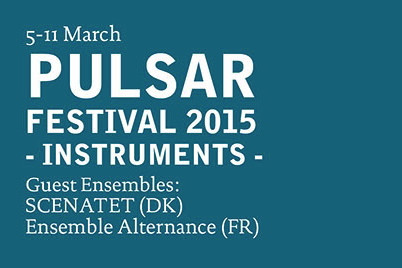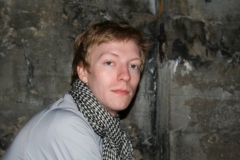
Pulsar Festival 2015 - De yngre komponister
Martin Stauning
- Torsdag d. 5 kl. 21:30 opføres "Semper Ubi/Pareidolia" (2014) på Studiescenen.
- Søndag d. 8 marts kl. 19:30 opføres "Where We Are There Is No Here" (2014) for accordeon og strygekvartet på studiescenen.
1. Hvilke noget musik lytter du til?
Jeg lytter til meget musik, og meget forskellig musik. Men der er alligevel nogle ting, jeg altid vender tilbage til: Liars, Godspeed You! Black Emperor, Radiohead, György Ligeti, Peter Ablinger, Salvatore Sciarrino.
 Martin Stauning2. Hvad er dine stærkeste minder om musik fra din barndom?
Martin Stauning2. Hvad er dine stærkeste minder om musik fra din barndom?
Lige fyldt syv år spillede jeg Marie’s søn i Alban Bergs Wozzeck. Placeret med benene hængende ud over orkestergraven under det berømte orkestermellemspil inden sidste scene (Invention over tonearten d-mol), mærkede jeg bevidst for første gang, at musik kan gøre noget fysisk ved os. Håret rejser sig, hjertet banker hurtigere, man bliver stakåndet. Det minder om noget.
3. Hvordan blev du bevidst om, at du ville komponere?
Jeg havde skolekammerater, der kunne spille klaver. Det fik jeg aldrig rigtig lært. I stedet for at spille det, andre havde lavet, syntes jeg som barn, at det kunne være sjovere at lave noget selv.
4. Hvilke emner optager dig i dit kompositoriske virke?
Musikkens flygtighed på alle måder. Fragmenteret tematik. Form som et stillads hvorpå man kan hænge sin pressening af tid, lyd og rum.
5. Hvordan vil du beskrive dit værk(er), som bliver opført på Pulsar?
Til Pulsar opføres to meget forskellige værker, der dog er beslægtet: Det ene, "Semper Ubi", er en undersøgelse af klaustrofobi og fremmedgørelse, gennem brug af mikrofoner, performerens fysiske fremtræden og ageren. En både klanglig og visuel tilstand af at “drukne i luften”.
Det andet, "Where We Are There Is No Here", er ligeledes en slags behandling af fremmedgørelsen, om end på mere positiv vis: Titlen kan læses på enormt mange måder. En (måske for transcendental) læsning kunne være en opfordring til at opløse begrebet “her” og lade musikken blive en tilstand.
Aya Yoshida
- Søndag d. 8 marts kl. 19:30 opføres soloen "Retro-Future" (2013)for bratsch på studiescenen.
1. Hvilke noget musik lytter du til?
I listen to not only contemporary music/classical music but also jazz, pop music and traditional music.
 Aya Yoshida2. Hvad er dine stærkeste minder om musik fra din barndom?
Aya Yoshida2. Hvad er dine stærkeste minder om musik fra din barndom?
I don’t have such a strong memory, but my parents have really liked listening to music. They are not musicians though. So,when I was young, they let me go to choir and kids orchestra (I had studied cello for 6 years) and go to a lot of concerts.
3. Hvordan blev du bevidst om, at du ville komponere?
When I was 3 years old, I started studying piano and when I was 6, I started composing my music, because my piano teacher suggested me to do so. I liked creating something (drawing and painting too) since I was very young and I used to play my music in a concert. Also I tried some composition competitions for kids.
4. Hvilke emner optager dig i dit kompositoriske virke?
Fashion is one of my big factors (topics) for my composing. I’m often inspired by fashion, fashion week, textures and fashion designer’s aesthetics.
5. Hvordan vil du beskrive dit værk(er), som bliver opført på Pulsar?
My viola solo piece will be performed on 8th March in Pulsar festival. I quoted Japanese traditional folk song in the piece and I focused on my identity as Japanese and the nature of the instrument when I composed the piece. I hope it will be good opportunity to look at my identity objectively.
James Black
- Torsdag d. 5 marts opføres i Konservatoriets Koncertsal "Silk" (2014) for erhu og ensemble.
- Fredag d. 6 marts kl. 21:30 uropføres på studiescenen "Your clone continues to run for his life" (2014) for carophone, lever harp og elektronik i to satser.
- Søndag d. 8 marts kl. 19:30 uropføres på studiescenen "Smoking mountain, and the sound of trumpets, and the life of road, and the sun came (two of them)" for 2 klaverer.
- Mandag d. 9 marts kl. 19:30 uropføres på studiescenen "The Gospel Accordion 2" (2014) for accordeon solo
1. Hvilke noget musik lytter du til?
I'm just going to list the top ten most played songs on my itunes library:
Sparks - Beat the clock
Kate Bush - The sensual world
Jackie DeShannon - So long Johnny
Kate Bush - Love and anger
Azealia Banks - 212
Janelle Monae - Dance or die
Jackie DeShannon - What the world needs now (is love sweet love)
Dionne Warwick - Anyone who had a heart
Petula Clark - This girl's in love with you
Donna Summer - MacArthur Park
Two main features of this list: nine out of ten of these songs are by female solo artists and four out of ten were written by Burt Bacharach. To the list I would like to add: Grace Jones, Sonic Youth, Arcade Fire, Ligeti, Messiaen, Percy Grainger, Stravinsky, Steve Reich, Prince, Of Montreal, Klaus Nomi - but the numbers don't lie and I have to own it.
Hvad er dine stærkeste minder om musik fra din barndom?
Earliest musical memories: singing hymns in church and school (and refusing - my old school reports all say "James likes music but he refuses to sing"), listening to the terrible soft rock easy-listening music that my dad enjoyed on long car journeys (that I now love - Stockholm syndrome), singing nonsense songs with my family, making up my own words to cartoon theme songs/video game music that didn't have any, playing the same tiny piano pieces with names like "Little Bee" or "The Cat's Pyjamas" over and over again, being sung to by my mother, the music written for books on tape that I listened to to fall asleep.
3. Hvordan blev du bevidst om, at du ville komponere?
I started composing in earnest during my bachelor's in England when a friend pulled out of a contemporary music workshop at the last minute. He was only allowed to quit if he could find someone to replace him and he asked me. I had a piece ready from my composition lessons so I submitted that. After that I just kept going and now I am here.
4. Hvilke emner optager dig i dit kompositoriske virke?
I think a lot about drag queens and drag culture and how they are in a sense 'performing themselves' when they do what they do. Anyone can slap on some makeup and put on a dress - a really successful drag performance is a committed one, taking it 100% seriously (but not so seriously that you lose sight of the essential ridiculousness and artificiality of the act) and putting their personality into it - something so artificial and constructed becomes incredibly personal and sometimes even moving because of the person constructing it. This is what I'm aiming for: I want to make something personal that only I could have written - not a work of great technical skill that will impress people (though that is nice too), but something so specific and human that it communicates myself effectively with no uncertainty and a total commitment to the act.
5. Hvordan vil du beskrive dit værk(er), som bliver opført på Pulsar?
I am having four works performed at this year's Pulsar festival.
"Silk" is a small concertino for Erhu (chinese fiddle) and ensemble, which will be performed in the opening concert by Scenatet with the Erhu player Yan Yan. It was written for the MEETINGS international composition competition where the task was to write music that combined Western instruments with traditional Chinese instruments. I chose the Erhu because I've always been fascinated by the timbre of the instrument - somewhere between and flute and a violin. The goal was to showcase the instrument but obviously I am me so there is a fair amount of myself in there too.
"Smoking mountain, and the sound of trumpets, and the life of the road, and the sun came (two of them)", for two pianos, is a very dense and virtuosic work. I started the piece by playing around with creating different piano textures and combining them in various ways. While writing the work I learned that sometimes (in fact, probably always) it is better not to try and capital-c Create but to simply put things in motion - to open up spaces where textures and ideas can freely speak and interact with each other.
"The Gospel Accordion 2" for solo accordion is an extension of this idea. It is again a very virtuosic work and is quite similar to Smoking mountain. But whereas in Smoking mountain I was trying to combine different textures to create a cohesive whole, The Gospel Accordion 2 takes one texture (two alternating notes) and expands from there. As I was writing the piece, lines, shapes, and textures suggested themselves to me (again, opening up spaces rather than Creating) and the goal became to allow these ideas enough time to properly speak and be heard.
The last piece, "Your clone continues to run for his life", is vastly different in style and outlook. It is a short piece in two movements for carophone (a hybrid of trombone and saxophone that I am playing), lever harp, and electronics. The style is very tonal and straightforward. Although it may sound very different from the other pieces, the underlying philosophy is the same - I want to give my ideas the space to be heard and understood. In this case, the carophone is the central idea, so I have kept the rest of the piece incredibly simple.


